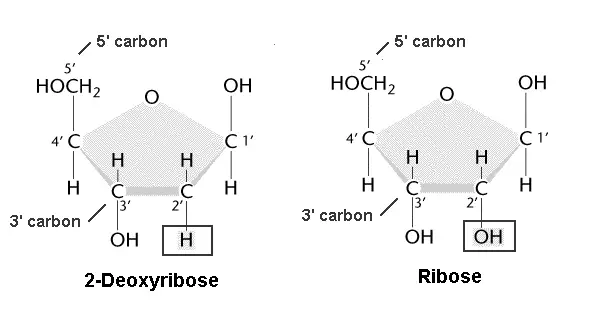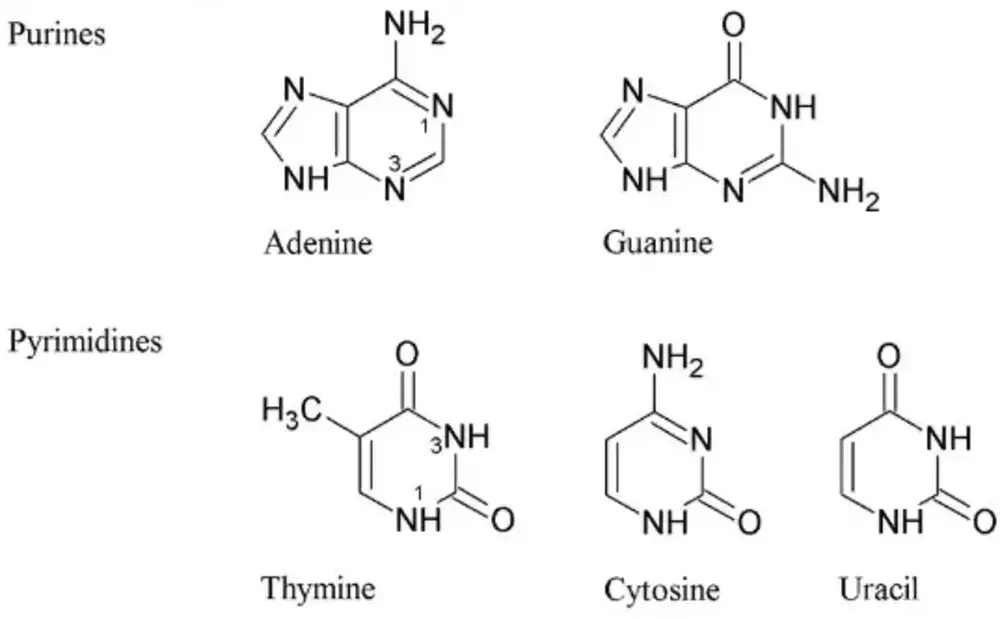How is RNA related to DNA? – (Relation Between DNA & RNA)
RNA is related to DNA in a number of ways. Both are genetic materials, nucleic acids, help in gene expression, somewhat similar in structure, and they both are dependent on each other.
Moreover, RNA is related to DNA as they both are linear polymers that consist of pentose sugars, phosphates, and bases, but there are some key differences that separate the two.
RNA (Ribonucleic acid) and DNA (Deoxyribonucleic acid) are both nucleic acids involved in gene expression and genetic mechanisms.
RNA is single-stranded while DNA is double-stranded. DNA is more stable than RNA.
The big difference is that DNA contains Adenine(A), Guanine(G), Cytosine(C), and Thymine(T) as nitrogenous bases. Whereas, RNA contains Adenine(A), Guanine(G), Cytosine(C), and Uracil(U) as nitrogenous bases.
This change in the nitrogenous bases between Thymine(T) in DNA and Uracil(U) in RNA also allows the RNA to translate required proteins which are not possible in the case of DNA.
- How is RNA related to DNA? The relationships between RNA and DNA
- 1. Both contain Pentose Sugar
- 2. Both are made up of monomer called nucleotides
- 3. Both contain 3 bases: Adenine, Guanine, and Cytosine in common
- 4. Both contain phosphate group
- 5. Both contain genetic information
- 6. Both take part in gene expression
- 7. Both controls the Central Dogma of Biology
- 8. Both are evidence for evolution
How is RNA related to DNA? The relationships between RNA and DNA
1. Both contain Pentose Sugar

Both DNA and RNA contain Pentose (five-carbon) sugar in its strand. The Pentose sugar in DNA is called Deoxyribose Pentose Sugar and the one in RNA is called Ribose Pentose sugar.
The main difference between the Deoxyribose Pentose Sugar of DNA and Ribose Pentose sugar of RNA is that Deoxyribose Pentose Sugar contains two Hydrogen (H) atom in the 2′ position whereas, Ribose Pentose sugar of RNA contains one Hydrogen (H) & one Hydroxyl (OH) in the 2′ position.
This (OH) hydroxyl group on the 2′ position makes RNA less stable than DNA because it is more susceptible to hydrolysis.
Carbon residues in the pentose are numbered 1′ through 5′. The nitrogenous base is attached to the 1′ position of the pentose sugar, and the phosphate is attached to the 5′ position.
It’s due to the 5 carbon similar structure that both are called pentose sugar, but it’s due to the presence of OH in the 2′ position that it’s called Ribose pentose sugar in RNA.
And also, it’s due to the absence of OH and presence of H in the 2′ position that it’s called Deoxyribose pentose sugar in DNA.
Each nitrogenous base (A, G, C, T/U) is attached to the Pentose Sugar via. an N-glycosidic bond.
Two adjacent Pentose Sugar of the strand is connected to each other to form the backbone of the DNA/RNA via. Phospho-diester Bond.
2. Both are made up of monomer called nucleotides

DNA and RNA are made up of monomers known as nucleotides. The nucleotides combine with each other to form a polynucleotide.
In both RNA & DNA, each nucleotide is made up of three components: a nitrogenous base, a pentose (five-carbon) sugar, and a phosphate group.
Monomeric nucleotides are the repeating units throughout the entire length of the DNA molecule inside each cell.
Each nucleotide is formed when a nitrogenous base (A/G/C/T/U) is attached to a pentose sugar molecule through N-glycosidic bond, which is attached to one or more phosphate groups via. Phospho-diester Bond.
In DNA, each nitrogenous base (A/G/C/T) in a nucleotide is attached to a Deoxyribose Pentose sugar molecule, which is attached to one or more phosphate groups.
And in RNA, each nitrogenous base (A/G/C/U) in a nucleotide is attached to a Ribose Pentose sugar molecule, which is attached to one or more phosphate groups.
Both contain nucleotide as a monomer and the only difference is that its Deoxyribose Sugar and bases A/G/C/T in DNA. And, its Ribose Sugar and bases A/G/C/U in the case of RNA.
3. Both contain 3 bases: Adenine, Guanine, and Cytosine in common

In common, both DNA & RNA contains nitrogenous bases Adenine, Guanine, and Cytosine. The only difference is that there’s Thymine in DNA ad Uracil in RNA.
These nitrogenous bases are organic carbon and nitrogen molecules.
Adenine(A) and Guanine(G) are classified as Purines. And Cytosine(C), Thymine(T), and Uracil(U) are classified as pyrimidines.
Purines are smaller two-ringed bases, while the pyrimidines are larger single-ringed bases.
The primary structure of a purine consists of two carbon-nitrogen rings. And, the primary structure of a pyrimidine consists of a single carbon-nitrogen ring.
They are called bases because they contain an amino group (NH2) that can bind extra hydrogen, and thus can decrease the hydrogen ion concentration in its environment, making it more basic.
That’s why they can create Hydrogen bonding with complementary bases.
4. Both contain phosphate group
Yes, in both DNA and RNA there is the presence of Phosphate groups in each strand.
A sugar-phosphate backbone joins together nucleotides in a DNA/RNA sequence.
Each of a Phosphate Group (PO₄³⁻) is attached to the hydroxyl (OH) group of the 5′ carbon of one Pentose sugar and the hydroxyl (OH) group of the 3′ carbon of the sugar of the next nucleotide. This resultantly forms a 5′–3′ phosphodiester linkage.
A polynucleotide may have thousands to millions of such phosphodiester linkages in a single strand of DNA or RNA molecule.
The phospho-diester bond is a covalent bond in which a phosphate group (PO₄³⁻) joins adjacent carbons of the deoxyribose pentose sugar through ester linkages.
This bond is also the result of a condensation reaction between a hydroxyl (OH) group of two sugar groups and a phosphate group.
5. Both contain genetic information
Yes, both DNA & RNA contain genetic information. DNA acts as the storehouse of genetic information and, RNA has the great capability of expressing the genetic information stored in DNA.
RNA in simple non-living organisms like retroviruses stores the genetic information. This can be seen when the retrovirus enters the host cell, it creates viral particles that replicates via. reverse transcription mechanism.
In common, DNA & RNA are long linear polymer of nucleotides called nucleic acids, that carry information in a form that can be passed from one generation to the next.
The only difference is that DNA carries genetic information in an encrypted form whereas, RNA carries the genetic information in an easily translatable form to create proteins.
DNA always remains present in the cells of the living organisms whereas, RNA only becomes visible during transcription and translation of DNA.
In viruses like retrovirus eg: HIV, etc. RNA is present which replicates, stores genetic information which only gets expressed as (DNA → mRNA → Protein) if the virus enters a living host cell.
6. Both take part in gene expression
Yes, in common both DNA & RNA take part in Gene Expression and are always in a sincere job to carry on the genetic information from one generation to the next.
The process by which a gene expresses its genetic information by producing the required number of proteins to bring on a genetic change in a living body is termed as Gene Expression.
A gene is simply a section of various nucleotides of the long DNA molecule that is present in each chromosome.
DNA simply cannot take part in gene expression, it has to work in a unit where each and every nucleotide of the DNA has its own job which together helps in gene expression.
And, when the section of DNA transcripts, it forms mRNA. mRNA (messenger RNA) with the help of tRNA (transfer RNA) and ribosome enzymes causes translation that is the formation of proteins.
RNA transcription makes an efficient control point because many proteins can be made from a single mRNA molecule. The protein-coding regions of mRNA are called exons.
This actually shows how both DNA & RNA are relatable and take part in Gene Expression being dedicatedly dependent on each other.
7. Both controls the Central Dogma of Biology

Both DNA and RNA takes part in the central dogma model of biology. It is via. this model that showcases how the genes of a living body are expressed by so-called gene expression.
The central dogma of molecular biology describes the two-step process properly viz. transcription and translation, by which the information in genes flows into proteins: (DNA → RNA → Proteins).
Before the 20th century, it was thought that proteins were only the genetic information carriers in a living body.
But in the 20th century, the discovery of nucleic acids (DNA & RNA) the mechanisms governing the specification and transmission of genetic traits were understood for the first time via. the central dogma model of biology.
This model states the flow of genetic information from DNA to mRNA. This is also known as Transcription, which is the process by which the information in a strand of DNA is copied into a new strand of messenger RNA (mRNA).
This model also states the flow of genetic information from mRNA to the amino acid sequence of polypeptide forming the proteins. This is also known as Translation.
In some viruses (retroviruses) the flow of information is in reverse direction i.e from RNA to DNA. This is called the central dogma reverse model.
RNA of these viruses first synthesizes DNA in the presence of Reverse Transcriptase enzyme. DNA then transfers information to RNA and then the translation occurs.
This is a piece of clear evidence that both DNA and RNA takes part in the central dogma model of biology and works together in expressing genetic information together.
8. Both are evidence for evolution
Both DNA & RNA are the prime evidence for evolution from the molecular biology point of view.
The Central Dogma shows how DNA is the self-replicating genetic storehouse of any biological body that is derived from their ancestors.
So, if you compare the DNA sequences of any organism you’ll find the evolutionary relationships between very different species over the course of evolution.
The DNA although has the power but directly cannot bring the genetic traits in the living body. So, DNA has to depend on the formation of RNA as an intermediate, and this RNA will form the structure of the proteins.
But, this DNA wasn’t the first formed one in the history of the emergence of living organisms from non-living ones.
RNA was first formed, and the after millions of years of evolution DNA emerged later from RNA.
It has been proposed that, at an early stage, life consisted of a self-replicating RNA system, and that DNA and proteins evolved later. This is in accordance with the RNA world hypothesis.
Later, during the 20th century, it was studied that the genetic information cannot be transferred among proteins, or from proteins to nucleic acids.
So, the emergence of DNA from RNA was proved according to the RNA world hypothesis in Evolution Biology.
And, Central dogma model evidently states that proteins are only formed when DNA produces RNA which produces proteins.
Thus, it can be clearly stated that both DNA & RNA are evidence for evolution. And proteins aren’t that evidence, as DNA produces RNA and RNA produces proteins respectively.
